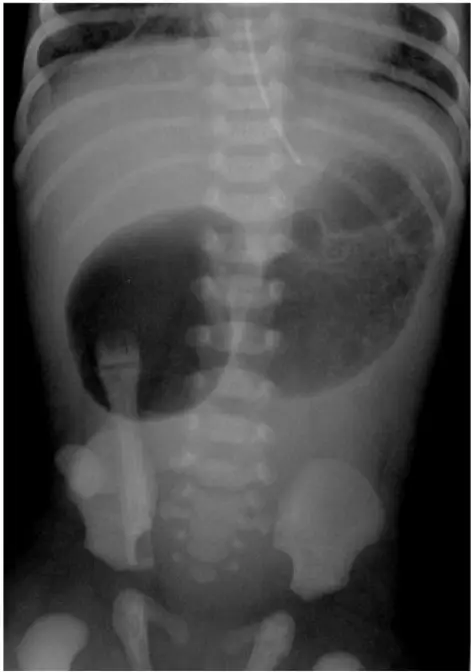
This abdominal X-ray demonstrates the “double bubble sign,” a classic radiographic finding in neonatal duodenal atresia. The two distinct air-filled bubbles represent the distended stomach and proximal duodenum, separated by the obstructed pylorus.
Xray showing Double bubble sign – image by Surgide.com
More Surgery Topics: Surgery
What is Duodenal Atresia?
Duodenal atresia is a congenital condition where a blockage forms in the duodenum (the first part of the small intestine). It often leads to vomiting—either bilious or non-bilious—within the first 24 to 38 hours after birth, typically following the first feeding. This condition is linked to polyhydramnios (excess amniotic fluid) during pregnancy and is one of the most common causes of fetal bowel obstruction.
Early diagnosis is possible through antenatal ultrasound. If not detected before birth, doctors use abdominal X-rays and sometimes contrast imaging (like barium studies) for confirmation. Unlike other conditions, CT scans have little role in diagnosis.
Causes of Duodenal Atresia
The main cause of this condition is a failure of the duodenum to properly form during fetal development, specifically between the 8th and 10th weeks of pregnancy. The blockage usually occurs distal to the ampulla of Vater (where bile and pancreatic ducts enter the intestine).
There are three main types:
- Complete obstruction (atresia) – No opening in the duodenum.
- Partial obstruction (stenosis) – Narrowing but not a full blockage.
- Duodenal web – A thin membrane causing a “windsock” deformity.
Who Is at Risk?
- Occurs in 1 in 5,000 to 10,000 live births.
- Strongly linked to Down syndrome (Trisomy 21)—about 30-40% of affected infants have it.
- Also associated with VACTERL syndrome, annular pancreas, and other bowel atresias.
- No significant difference between genders.
Symptoms and Diagnosis of Duodenal Atresia
Signs to Watch For
- Bilious vomiting (greenish-yellow) within 24-38 hours after birth.
- Abdominal distension (swelling).
- No bowel movements after birth.
Diagnostic Tests of Duodenal Atresia
- Prenatal Ultrasound – Shows a “double bubble” sign (stomach + dilated duodenum).
- Abdominal X-ray – Confirms the double bubble postnatally.
- Contrast Studies (UGI Series) – Uses barium or Pedialyte to confirm blockage.
- Neonatal Ultrasound – Helps rule out other conditions like midgut volvulus (a surgical emergency).
Note: CT scans are rarely used due to radiation risks in newborns.
Treatment Options of Duodenal Atresia
The primary treatment is surgery to remove the blockage. The most common procedure is duodenoduodenostomy, where surgeons create a bypass around the obstruction.
Surgical Approaches for Duodenal Atresia
- Open surgery – Traditional method.
- Laparoscopic (minimally invasive) surgery – Fewer scars but technically challenging.
Post-Surgery Care of Duodenal Atresia
- Nasogastric tube to decompress the stomach.
- IV fluids & nutrition until feeding resumes.
- Gradual reintroduction of breast milk or formula.
Possible Complications
- Anastomotic leak (rare but serious).
- GERD (acid reflux).
- Megaduodenum (enlarged duodenum with poor movement).
- Blind loop syndrome (bacterial overgrowth).
Despite these risks, most infants recover well with a low long-term mortality rate (6%).
When to See a Doctor
If your newborn shows:
- Persistent vomiting (especially green/yellow).
- No bowel movements after birth.
- Swollen abdomen, seek immediate medical attention.
A pediatric surgeon should be consulted for confirmed cases.
Outlook and Prognosis
With timely surgery, most babies with this condition thrive. Studies show a high survival rate, though some may experience late complications (12%).
Further Reading
- Mayo Clinic – Duodenal Atresia – Overview of symptoms & treatment.
- Cleveland Clinic – Neonatal Bowel Obstruction – Causes & surgical options.
- National Institutes of Health (NIH) – Research on congenital defects.
- Wikipedia – Duodenal Atresia – General background.
Final Thoughts
Duodenal atresia is a treatable condition when detected early. If your baby is diagnosed, early surgical intervention leads to excellent outcomes. Always consult a pediatric specialist for the best care.
